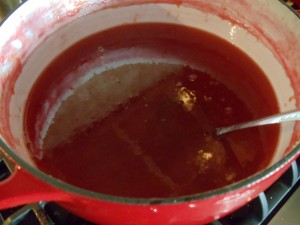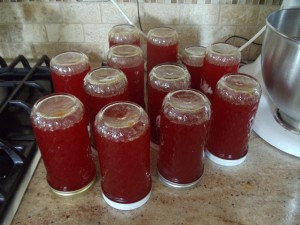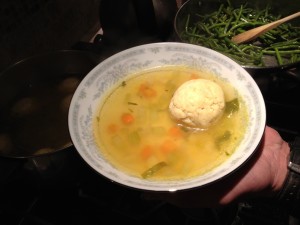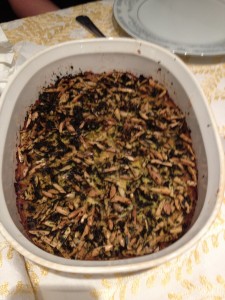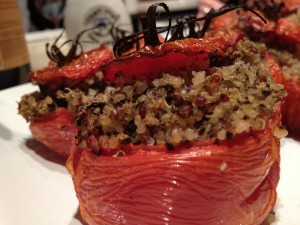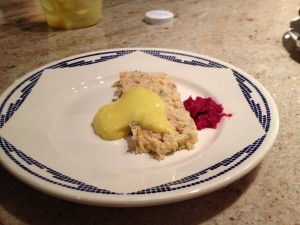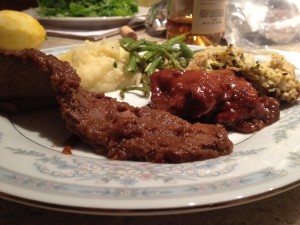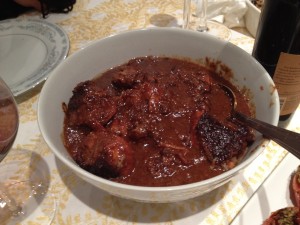Jul 13 2012
What Rhymes With Yum?
If it’s July, it’s got to be plum. Lots of them. You might actually call it a bumper crop; not quite as bumper-y as the one from 2010, which yielded about 60 lbs for the 1 (one) plum tree in our yard, but still. I’m not exactly sure which variety they are, but they are small, and rosy-red, and extremely juicy (as in: you-might-want-to-protect-yourself-before-biting-into-one-if-you-really-like-that-shirt-you’re-wearing juicy), and sweet. They are a perfect summer fruit, and I just had to do something with them – although in all fairness, the squirrels were doing a fine job of taking care of those plums. But I digress.
And so a decision was made that there would be plum jam, plum butter, plum ice-cream, and plum vodka (thanks to our cousin Stacy for that last suggestion). I would have liked to make chutney and other various condiments, but the plums I have are really too juicy and fall apart so easily that this was not an option. I’ll focus on the jam making today, but worry not, other recipes will soon follow.
Making jam is the easiest way to deal with an abundance of fruit. I remember my mother and her mother making assorted jams and jellies every summer, using fruit from the garden (never from the store), and this is how I learned. The best part of jam-making (other than eating the jam itself, obviously) is how good it makes the whole house smell, and the feeling you get from making something you know will remind you of warm days when the weather turns cold and gray.
Plums are a particularly good fruit to turn into jam, because they do not need very much coaxing to jell, i.e. to acquire that nice, spreadable consistency. You do have to add a little pectin to the batch, but – at least in the case of the plums I used – not very much. Because the skins on the plums can turn rater gummy if they cook in sugar, I recommend skinning the plums. The easiest way to do this is to plunge them first in boiling water, followed by a quick ice bath after 30 seconds or so in the hot water; the skins will slip right off. In my case, the plums were so ready to fall apart that I could neither skin nor pit them (something else you need to do). I had to cook them and (after they fell apart) wait for the skins and pits to rise to the surface – it was all fairly easy to remove from the pot after that.
Depending on the natural sweetness of your fruit, you will need to add anywhere between 70% and 85% of the weight of the plums in sugar in order to make jam. Recipes often call for equal weights of sugar and fruit, but I find that this generally tends to yield a jam that is more akin to a spoonful of sugar than to a spoonful of fruit, which defeats the purpose. You can also add flavorings to your jam: I find that vanilla works very well with plum (merci, Papa!), as does Grand Marnier. If you choose to add a liqueur, do so at the very end, after you have turned off the heat, so the liqueur does not burn and lose its character; do be careful as you add it in, as it will tend to bubble vigorously in the hot jam and splatter a bit.
Plum Jam with Grand Marnier
6 lbs prepared plums (any juicy variety; skins and pits removed; cut in small pieces)
4.5 lbs sugar
6 or 7 Tbsp powdered pectin
1 shot glass of Grand Marnier (optional)
Place plums in a large Dutch oven with a heavy bottom, over medium-low heat. Add 3 to 4 oz of water to the pan if your plums are not very juicy. Mine were, so I did not have to do this as they rendered a lot of liquid. Bring to a full boil and let cook until the fruit begins to fall apart (I would say around 15 min or so, but you might need more time). The plums I used fell apart so easily the jam I made is more or less like jelly – no chunks left in there at all.
Mix the pectin with about half of the sugar and add to fruit. Mix well. Add the rest of the sugar and mix well. Bring back to a boil. The mixture should not boil too quickly. The fruit and sugar will produce some foam at the edges of the pot. You should remove this with a slotted spoon or it will cloud your jam.
Cook the jam until it reaches the right consistency. You will know it’s right by putting a spoonful of the mixture on a plate and in the fridge. After a couple of minutes, the jam will have cooled. If it is too thin, let it cook a while longer and/or add a little more pectin (be sure to whisk it in or it will clump). If it looks set, turn off the heat. Add liqueur at this point, if desired.
Make sure your jars are sterilized before filling them (putting them through the dishwasher will take care of that). Boil lids and rings just before using, and leave them in the hot water until ready to use. Lids are not reusable, but rings are. Fill the jars carefully – the jam is extremely hot at this point, and you don’t want to scald yourself. Make sure you wipe the rims very clean with a wet paper towel before putting the lid and ring on. Tighten very well and invert the jar on the counter. Let cool in this inverted position. This will ensure a tight seal, and prevent spoilage of your jam.
You will know the seal is tight by checking the center of the lid when the jar is cool: if it is sunk, it worked and you can keep the jam for months in a cool, dark place; if it is raised and you can push it up and down, it did not seal properly – you can still eat the jam, but you should refrigerate it and consume it within a month or so (which should not be hard to do).
Up next: Plum ice cream and other delights. Stay tuned.


